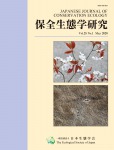Volume 25, Issue 1
Displaying 1-16 of 16 articles from this issue
- |<
- <
- 1
- >
- >|
-
2020Volume 25Issue 1 Article ID: hozen.25.1_Cover1
Published: 2020
Released on J-STAGE: June 28, 2020
Download PDF (4284K) -
2020Volume 25Issue 1 Pages Toc1-
Published: 2020
Released on J-STAGE: June 28, 2020
Download PDF (795K)
A Message from Editor in Chief
-
Article type: A Message from Editor in Chief
2020Volume 25Issue 1 Article ID: 25.1_1
Published: May 15, 2020
Released on J-STAGE: June 28, 2020
Advance online publication: May 15, 2020Download PDF (1940K)
Original Article
-
Article type: Original Article
2020Volume 25Issue 1 Article ID: 1901
Published: March 05, 2020
Released on J-STAGE: June 28, 2020
Advance online publication: March 05, 2020Download PDF (2005K) -
Article type: Original Article
2020Volume 25Issue 1 Article ID: 1902
Published: May 15, 2020
Released on J-STAGE: June 28, 2020
Advance online publication: May 15, 2020Download PDF (3394K)
Review
-
Article type: Review
2020Volume 25Issue 1 Article ID: 1822
Published: March 05, 2020
Released on J-STAGE: June 28, 2020
Advance online publication: March 05, 2020Download PDF (2935K)
Report
-
2020Volume 25Issue 1 Article ID: 1914
Published: February 13, 2020
Released on J-STAGE: August 28, 2020
Advance online publication: February 13, 2020Download PDF (921K) -
Article type: Report
2020Volume 25Issue 1 Article ID: 1809
Published: March 05, 2020
Released on J-STAGE: June 28, 2020
Advance online publication: March 05, 2020Download PDF (1197K) -
Article type: Report
2020Volume 25Issue 1 Article ID: 1924
Published: May 15, 2020
Released on J-STAGE: June 28, 2020
Advance online publication: May 15, 2020Download PDF (2929K) -
Increased breeding among Grus japonensis observed via aircraft surveys over northern Hokkaido, JapanArticle type: Report
2020Volume 25Issue 1 Article ID: 1910
Published: May 15, 2020
Released on J-STAGE: June 28, 2020
Advance online publication: May 15, 2020Download PDF (6179K) -
2020Volume 25Issue 1 Article ID: 1825
Published: May 15, 2020
Released on J-STAGE: June 28, 2020
Advance online publication: May 15, 2020Download PDF (7961K) -
Article type: Report
2020Volume 25Issue 1 Article ID: 2002
Published: May 15, 2020
Released on J-STAGE: June 28, 2020
Advance online publication: May 15, 2020Download PDF (1926K)
News
-
Article type: News
2020Volume 25Issue 1 Article ID: 1908
Published: March 05, 2020
Released on J-STAGE: June 28, 2020
Advance online publication: March 05, 2020Download PDF (826K)
-
2020Volume 25Issue 1 Pages 123-129
Published: 2020
Released on J-STAGE: June 28, 2020
Download PDF (829K) -
2020Volume 25Issue 1 Pages App1-
Published: 2020
Released on J-STAGE: June 28, 2020
Download PDF (795K) -
2020Volume 25Issue 1 Pages Toc2-
Published: 2020
Released on J-STAGE: June 28, 2020
Download PDF (4284K)
- |<
- <
- 1
- >
- >|
